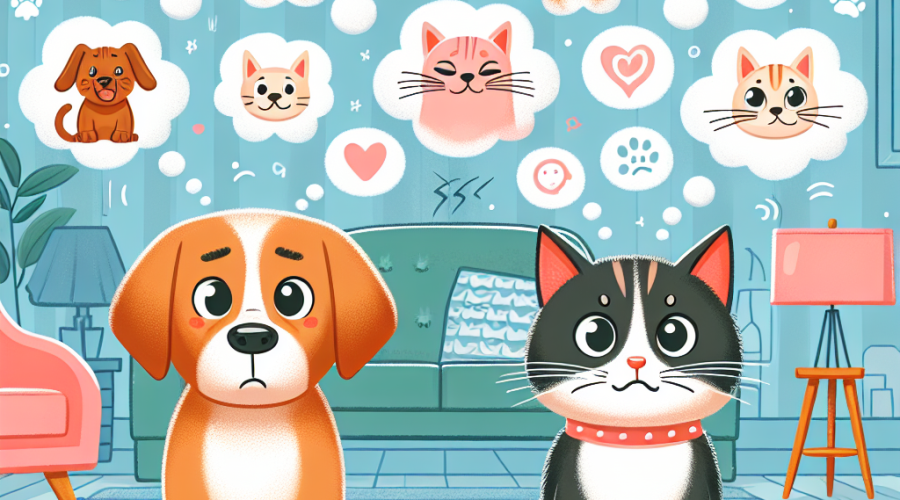How to Read Your Pet’s Mind with These Signs
Ever wondered what your pet is thinking? You’re not alone. Millions of pet owners around the globe ponder over this question daily. Unlike humans, our furry friends can’t verbalise their thoughts and feelings. But, what if I told you that with a bit of observation and understanding, you can get a glimpse into your pet’s mind? Yes, you read that right! Our pets, whether they’re the tail-wagging or the purr-producing kind, give away signs that can help us understand their needs, desires, and feelings. Intrigued? Let’s dive deeper into this fascinating topic.
First off, it’s crucial to understand that pets communicate through body language. Just like humans, they use non-verbal cues to express themselves. The tail, ears, eyes, and posture are your pet’s tools for expression. Each movement or position can unveil a plethora of information about what they’re thinking or feeling. For instance, a wagging tail doesn’t always mean happiness in dogs; it can also indicate nervousness or agitation. Similarly, when your cat’s tail puffs up, it’s not just trying to appear bigger; it’s likely scared or agitated. Thus, paying close attention to these subtle cues can be your first step towards understanding your pet’s mind.
Understanding your pet’s vocalisations is another key piece of the puzzle. Dogs bark, whine, growl, and howl; each sound carries a different meaning. Cats, on the other hand, might meow, purr, hiss, or chirp. The trick is to listen to the tone, volume, and context. A high-pitched bark or meow could signal excitement or a plea for attention, whereas a low-pitched growl or hiss might indicate annoyance or discomfort. By tuning into these sounds, you can start to decipher what your pet is trying to communicate.
Let’s talk about the eyes, often said to be the windows to the soul. This saying isn’t just applicable to humans; it holds true for our pets as well. The way your pet looks at you can convey a multitude of emotions. Direct eye contact from a dog, coupled with a relaxed posture and wagging tail, usually means they’re happy and trusting. Avoiding eye contact, however, might mean they’re feeling guilty or submissive. Cats, however, can find direct eye contact threatening. A slow blink from your feline friend is a sign of trust and affection, akin to a kitty kiss.
Behavioural changes can also be a tell-tale sign. A pet that’s normally full of energy but suddenly becomes withdrawn or lethargic could be unwell or stressed. Conversely, a typically calm pet that starts to exhibit destructive behaviour or excessive vocalisation might be bored or seeking attention. It’s essential to note any sudden changes in behaviour, as they can be indicative of underlying issues that need addressing.
Bonding activities can significantly enhance your understanding of your pet’s mind. Spending quality time together, whether it’s playing, grooming, or simply cuddling, can strengthen your bond and increase your ability to read each other’s cues. Through these interactions, you’ll start to notice patterns in your pet’s behaviour that are unique to them. This personalised understanding is key to truly getting a glimpse into what your pet might be thinking or feeling.
While we may never be able to read our pets’ minds with absolute certainty, paying attention to their body language, vocalisations, eye contact, behavioural changes, and engaging in bonding activities can provide us with a deeper understanding of their thoughts and feelings. Remember, each pet is unique, and learning to read their specific signs takes time and patience. So, the next time you find yourself wondering what your pet is thinking, take a moment to observe and listen; you might be surprised at how much they’re actually communicating. By fostering a deeper connection with your pet, you not only enhance their well-being but also enrich your shared lives together. After all, isn’t that what being a pet owner is all about?
FAQs
Q: How can I tell if my pet is feeling happy?
A: Your pet’s happiness is often shown through their body language, such as a wagging tail or relaxed posture. Ears perked up and a willingness to play are also clear indicators of a cheerful mood.
Q: What signs indicate that my pet is feeling stressed or anxious?
A: Stress or anxiety in pets can manifest as excessive panting, hiding, or showing signs of aggression. Additionally, a change in eating habits or excessive grooming can signal their discomfort.
Q: How can I understand if my pet is in pain?
A: A pet in pain may become more withdrawn, show a decrease in activity, or exhibit vocalisations like whimpering. They may also limp or show reluctance to be touched in areas that hurt.
Q: Are there any signs that show my pet is feeling bored?
A: Signs of boredom in pets include destructive behaviour, such as chewing on furniture or shoes, and an increase in pacing or other repetitive movements. They may also vocalise more or show a lack of interest in activities they usually enjoy.
Q: How can I recognise if my pet wants attention or affection?
A: Pets seeking attention might nudge your hand or place their head in your lap, showing they desire petting or playtime. They may also follow you closely around the house or bring toys to you as an invitation for interaction.

